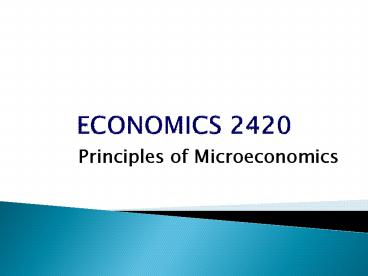ECONOMICS 2420 - PowerPoint PPT Presentation
1 / 19
Title:
ECONOMICS 2420
Description:
Principles of Microeconomics E-mail Communication- Use mtmail or D2L for all communications pertaining to the this course. Use of cellphones or other electronics ... – PowerPoint PPT presentation
Number of Views:92
Avg rating:3.0/5.0
Title: ECONOMICS 2420
1
ECONOMICS 2420
- Principles of Microeconomics
2
Important Information
- E-mail Communication- Use mtmail or D2L for all
communications pertaining to the this course. - Use of cellphones or other electronics gadgets
are not allowed because it is a distraction to
your neighbor and me. Please turn them off
during class period at all times. - We have MA and Ph. D students who can answer most
your questions during lab hours, if you need them.
3
A conducive Learning Environment
- Come to class on time and stay until it is over
- Turn off your cell phones during class period at
all times - Come to class with a purpose to learn economics
- Ask questions, if you dont understand
- Take notes as relevant to learn
4
A conducive Learning Environment
- Bring Good attitude Love of wisdom Smile
(laughter, humor)gt conducive learning
environment. - Learning and teaching are a two way process.
- I pledge to do my best to make the course
relevant and I request that you also do your part
to make the course successful.
5
Why Study Economics? 3Reasons
- Helps individuals to make rational choices or
decisions for maximizing their welfare
(satisfaction). Some examples include - (major, working vs attending school, allocating
time to different activities, choosing a mate,
making informed decisions in civic duties,
evaluating economic platform of candidates for
public office, etc.)
6
Why Study Economics?
- Guides companies (firms) to make efficient
resource allocation decisions to maximize profit - Helps non-profit organizations (schools,
hospitals, museums, churches, etc. to maximize
service to their clients
7
Why Study Microeconomics?
- Its useful for
- Personal Decisions
- Business Decisions
- Political Decisions
- It pays
- Economics majors end up making more money on
average relative to many other majors
8
2008 Average Starting Salaries
- Major Salary
- Computer Science 56,921
- Engineering 56,336
- Economics 52,926
- Nursing 52,129
- Chemistry 52,125
- Finance 48,795
- Accounting 47,413
- Bus./Mgt 43,823
- Source MSN Careers mancareerbuilder.com
9
1. What is economics all about ?
- It deals with
- a. scarcity of productive resources
- -Labor (doctors, lawyers, teachers, etc.)
- -Capital ( physical financial )
- -Land ( minerals, petroleum )
- -Management or Entrepreneurship (CEO)
- b. choices ( individual, regional, national,
- and international levels)
10
1. What is economics all about ?
- c. Efficiency - getting the most output from
scarce resources - d. Equity fair distribution of benefits or
goods and services. - Economics is the study of mankind in the ordinary
business of life ( Alfred Marshall-1791) - Allocation of parking spaces, deciding how many
credit hours to take, deciding what to major
(business vs LA, Sciences) considering career
opportunities, working or going to school, etc.
are all economic decisions
11
Economic Problem
- 2. The economic problem arises from the unlimited
human wants relative to limited resources. - 3. The scarcity - choice - opportunity cost
framework. Because of scarcity, we must make
choices and the choices we make entail costs (OC)
- 4. Opportunity cost - the value of the best
foregone alternative. - Examples OC of going to school gtincome you
would earned working - OC of big building stadium gt other services
given up (library, computing, housing services) - OC of using land for wild life gt other things
land can be used for
12
4. An Example of Constant Opportunity
Cost Budget 5.00 PHD 0.50 PHAM1.00
13
A Case of Constant OC
- What is the OC of the 1st , 2nd, 3rd , 4th, and
5th Ham?
Hotdogs
10
8
OC -2/1 gt sacrifice/gain
6
4
2
Ham
5
0
1
2
3
4
14
A Case of Constant OC
- Note 1) the opportunity cost of each additional
hamburger is the 2 hotdogs which must be given
up. This is a case of constant OC. - Note 2) A constant OC implies prefect
- substitution of resources. Not realistic in
- many instances.
15
5. Every society must answer three basic
questions.
- What to produce? ?Consumers
- How to produce? ?Firms
- Who gets the goods and services produced? ?
Market and Social Policy
16
6. Mechanisms of resource allocation
- Market forces of supply and demand.
- State makes the resource allocation in a command
economy. - Market and state make resource allocation
decisions (US and others).
17
7. Ten Principles of Economics (Mankiw)
- How People Make Decisions?
- Principle 1 People Face Tradeoffs
- Principle 2 The Cost of Something is What
- You Give Up to Get It
(OC). - Principle 3 Rational People Think at the
- Margin.
- Principle 4 People Respond to
Incentives.
18
B. How people Interact
- Principle 5 Trade Can Make Everyone
- Better Off.
- Principle 6 Markets are Usually a Good
- Way to Organize
Economic - Activity.
- Principle 7 Governments Can Sometimes
- Improve Market
Outcomes
19
C. How the Economy as Whole Works
- Principle 8 A Countrys Standard of living
- Depends on Its Ability to
Produce - Goods and Services
- Principle 9 Prices Rise When the Government
- Prints Too Much Money
- Principle 10 Society Faces a Short-Run
- Tradeoff Between
Inflation and - Unemployment

